Upstate New York
Many associates "New York" with the city but unlike the small neighboring states the State of New York is truly expansive (larger than the entire New England save for Maine) and merely a half of its population live in the NYC. The state's remaining part is nicknamed Upstate New York. It consists of smaller cities where the population has halved since the 1960s (total regional population remained the same).
Seven of these cities have old Lithuanian communities with old churches and cemeteries. Unfortunately, the recent years have been sad to them: local dioceses have closed all the Lithuanian parishes that survived a century or more. Not only the Lithuanian mass would be canceled but the buildings themselves were sold to other religions in many cases, destroying or damaging the Lithuanian-inspired interiors. Some exterior Lithuanian details often remain though.
The cemeteries, where they exist, still survive, offering a glimpse to Lithuanian surnames and their anglicizations.

Amsterdam St. Casimir Lithuanian chruch.
Mohawk Valley Lithuanian heritage
Mohawk Valley, a conurbation around the New York state capital Albany, had 3 Lithuanian churches, a chapel and 2 cemeteries.
With some 2,5% of its population of Lithuanian heritage, Amsterdam is the most Lithuanian city in the New York state. It has a large Lithuanian cemetery (Cemetery Rd.), unique for having many of its gravestones inscribed with two surnames: one original Lithuanian and the other one Americanized (i.e. the one immigrants were made to take by the immigration authorities who misheard the surname).

Amsterdam cemetery in New York. This grave has both the Lithuanian (Balčys) and Anglicized (Baltch) surnames marked, and the Lithuanian sun-cross as an ethnic symbol that unites Christian and Pagan beliefs.
At the heart of the cemetery stands St. Anne chapel commissioned by a Lithuanian Kiškis for his beloved wife and built by a famous Lithuanian-American author V. K. Jonynas in 1971. It now serves as a location for the funerary rites with are banned at the graveside in the diocese (previously it also served for the storage of the dead bodies through the winter). The exterior has Lithuanian inscriptions and the Lithuanian sun-cross, a traditional Lithuanian ethnic symbol, as well as bas-reliefs of St. Anne and St. Casimir (with the Lithuanian names of these saints written, Ona and Kazimieras).

St. Anne chapel in the Amsterdam Lithuanian cemetery of New York. The facade incorporates the Lithuanian sun-cross.
The cemetery also has a memorial for local Lithuanians who died in America's wars (6 in WW1, 17 in WW2 and 3 in Vietnam, according to the inscribed surnames).

A memorial for the Lithuanians who died in America‘s wars at the Amsterdam Lithuanain cemetery.
Amsterdam St. Casimir church has been sold to Buddhists after its closure; they established the Five Buddhas Temple there. The community leader Lucas Wang (a.k.a. Holy Master Ziguang Shang Shi) claimed that he received a revelation to purchase the church. United into the World Peace and Health Organization the local Buddhists plan a massive expansion that will even include theme park - but the fate of Lithuanian details of the St. Casimir church is likely sealed. Amsterdam Buddhists typically don't allow outsiders inside, although some sources claim the stained glass windows remain there. The most striking reminder of Lituanity is the St. Casimir statue with Lithuanian inscription on the tower.

St. Casimir statue still remaining on the Amsterdam Lithuanian church facade, with a Lithuanian inscription.
Previously the church area hosted other Lithuanian institutions such as Pakėnas laundry, Piliponis grocery. Today their owners are probably resting in the St. Casimir Lithuanian Cemetery.
The Lithuanian memorabilia from the church (once collected by the priests who visited Lithuania) had been relocated to Walter Elwood museum of Amsterdam history, where many artifacts are presented in a former factory (one in which many Lithuanians surely worked as well).
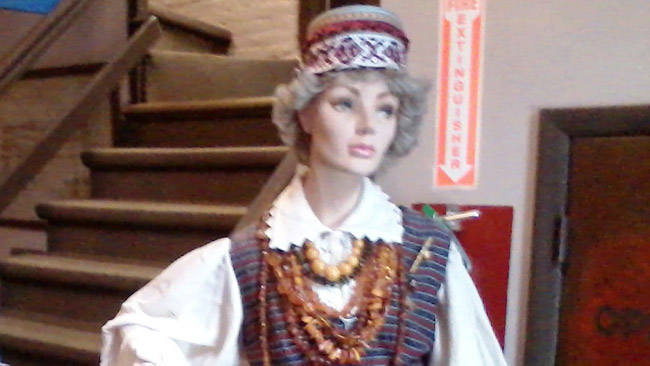
A Lithuanian exhibit in the Walter Elwood museum.
The Lithuanian church building with a dome survives in Schenectady, another Mohawk Valley city (Holy Cross church, 19 N. College Street). It doesn't look like a church as it was built to be a synagogue in 1891; in 1920, however, Jews sold it to Lithuanians as they built a bigger synagogue. Currently, nothing reminds of the buildings many-decades-long Lithuanian history after it was transformed into a stained-glass workshop. A large Lithuanian wooden wayside cross that used to stand outside has been removed or destroyed.

The former Lithuanian church at Schenectady.
Schenectady also has a rather small Holy Cross Lithuanian cemetery (est. 1930). As the parish also had, in later stages, many Italians as its members, the cemetery also has Italian graves. Throughout its history, however, the parish remained mainly Lithuanian and was not rededicated to any other ethnic group.
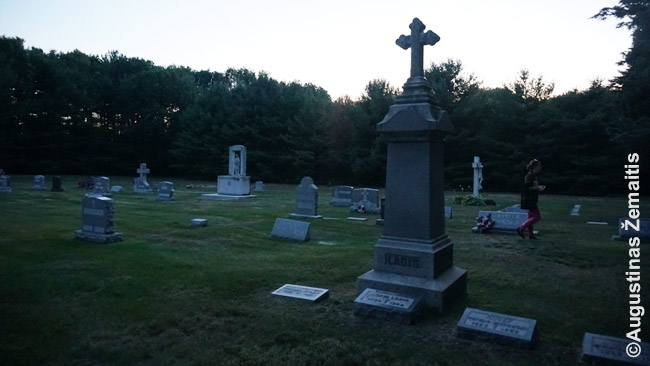
Lithuanian cemetery at Schenectady.
Schenectady is a suburb of the state capital of Albany. Albany itself had a Lithuanian church of St. George once (corner of Thornton and Livingston streets). Built in 1917, it has been closed in 1986. Today the building is used as a community center/soup kitchen dedicated to Sister Maureen Joyce. Blessed Mary statue from the original church, as well as a plaque reminding of Lithuanian history, remains (immediately beyond the entrance) but the interior was destroyed. According to priest Valkavičius who documented Lithuanian churches, the interior used to be shown to architecture students in how to create a grandeur with little available as the church had a pretty tin ceiling. All that was destroyed when transforming into the soup kitchen, however, due to fire prevention requirements (sprinkler installation). Stations of the Cross have been moved to the Lithuanian camp Neringa chapel in Brattleboro. That said, the Albany church was never especially rich in decor, as it was basically just a basement with a wooden belfry: the community never did build a full church which was planned on top of the current church. Therefore, the church never even had stained glass windows.
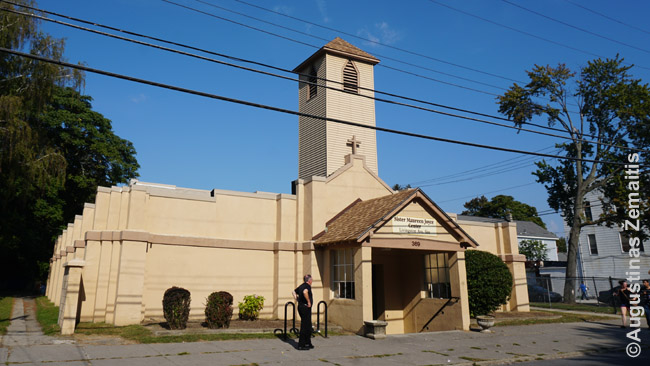
Albany St. George Lithuanian church.
Rochester Lithuanian heritage
Rochester is arguably the liveliest Lithuanian community in Upstate New York and is only second to Mohawk Valley in Lithuanian heritage. Rochester attracted most of its ~400 Lithuanians ~1900 as they have been fleeing hard labor in Pennsylvania mines.
The historic hub of the Rochester Lithuanian community was the St. George Lithuanian church. Like many Lithuanian-American churches, it began as a community praying at other churches, until it has acquired land and built a multi-purpose building.
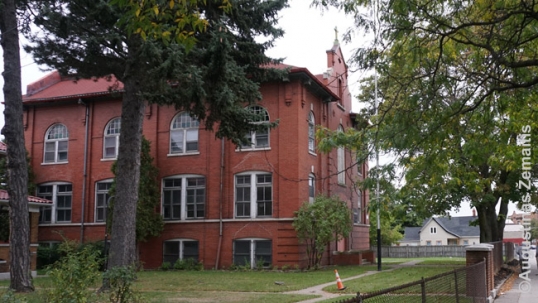
The initial St. George Lithuanian church, later St. George Hall
That building, known as the St. George Hall (erected 1910), is a 3-floored edifice that used to contain church hall, Lithuanian school, an events hall and, since 1976, a Lithuanian Ethnic Museum. The Lithuanian Hall was sold in the 2000s to a Puerto Rican community. Nothing Lithuanian remains at the outside but the event hall still has a Lithuanian coat of arms (as of 2019).
In the late 1920s, Lithuanians planned to expand their church but opted to build a new one nearby, thereby leaving the old building just for the school and events.

Rochester St. George Lithuanian church
The St. George Lithuanian church of Rochester has been built in 1934. It has been sold to Puerto Ricans in the 2000s, together with the Hall and other buildings on the lot. It now serves as a Hispanic independent non-denomination Christian church, however, the stained-glass windows with Lithuanian inscriptions remain inside. Some of the Lithuanian details have been removed by Lithuanians themselves, including the entrance stone and the murals of Our Lady of Šiluva and Our Lady of Vilnius that used to be above the altar. Many of such items, as well as the items from the Lithuanian museum, have been sent to Lithuania according to the local community, although it is unclear where they are now.

Original stained glass window depicting the Vilnius Three Crosses monument
The former Lithuanian lot also has a rectory (without any Lithuanian details) and it had a wooden Franciscan monastery which has been demolished.
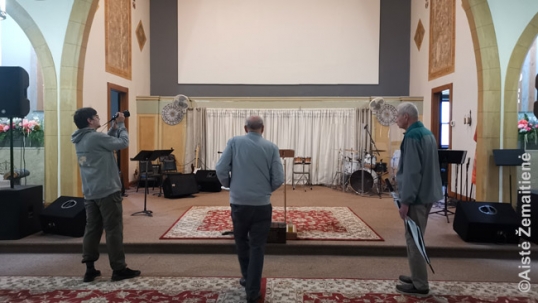
The murals around the altar (over the side-doors) were removed by Lithuanians before the transfer of the building. The walls are thus now empty. The murals used to depict Our Lady of Vilnius (Gate of Dawn) and Our Lady of Šiluva, two major images of Maryan devotion in Lithuania
As the 20th century progressed, the district where the Lithuanian complex was located gradually became ghettoized. The Lithuanians generally moved out in some 1950s-1960s but they continued to come for the Mass and the events. There were proposals to move the church in some 1970s but they did not come through as the priests changed. As the district deteriorated further and the number of Lithuanians declined through intermarriage, it became harder and harder to keep the church going. The financial crisis of 2008-2009 proved to be the final hit, as donations dwindled. Unlike in many other places, however, it was not the diocese that closed the Lithuanian church but rather the parish itself. Officially, the parish remained, however, it now uses another church of Our Lady of Lourdes for its masses.

Lithuanian cross at Our Lady of Lourdes parish, moved from the old St. George church
Such an arrangement allowed to move some of the Lithuanian character from St. George Lithuanian church to the Our Lady of Lourdes Church. In Our Lady of Lourdes, there is a traditional Lithuanian cross at the entrance (moved from St. George and dedicated now to St. George church), as well as some of the articles from St. George Hall Lithuanian museum, as well as a small Lithuanian library and school. There are now „shrines“ to Our Lady of Vilnius as well as a symbolic Lithuanian memorabilia shelf there.
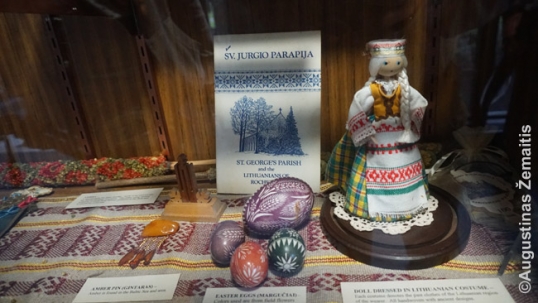
One of the Lithuanian memorabilia shelves at the Our Lady of Lourdes parish
The memorial to Lithuanian war veterans that used to stand in front of the St. George Hall has been relocated to Holy Sepulcher cemetery near the US veteran graves. The memorial was constructed in 1952 by the Gudinas post of the American Legion. While the American Legion is a US veteran organization, this particular Rochester post was named after a Lithuanian war veteran Jonas Gudinas and consisted of ethnic Lithuanian US veterans. Jonas Gudynas was born in Raguva, Lithuania, in 1891, immigrated to Rochester in 1910, joined the American army in 1918 and was killed in France the same year, less than a month before World War 1 ended.

American Legion Gudinas post memorial
Rochester also had a Lithuanian Gediminas club that was associated with the leftists. The building, located on the corner of Joseph and Clifford streets and acquired by the club in 1912, has been demolished as the club was closed down sometime in the 1960s. Near the Gediminas club, the racial riots (Black uprising) of the 1960s took place, one of the events that brought down the district.
In order to perpetuate Lituanity after all the Lithuanian buildings were closed, ~100 Rochester Lithuanians have established a Lithuanian Heritage Society. In 2010 the city established sister ties with Alytus, Lithuania.
Niagara Falls Lithuanian church
Merely 2 km from the world-famous Niagara Falls one may see a century-old Lithuanian coat of arms proudly chiseled on a pediment of a rather grand neo-classical building (1910 Falls Street).
The building used to be St. George's Lithuanian church. Some 100 years ago, the Niagara Falls were used to power industry and many Lithuanians immigrated to staff it. They have built this church as their community hub in 1928. The church reminds of a Greco-Roman temple on the outside. There are Lithuanian details both inside and out. Outside, in addition to the pediment Coat of Arms, there is a small monument dedicated to Rev. Francis J. Aukstakalnis, the Lithuanian priest who served there. Inside, there are 14 stained-glass-windows mostly with Lithuanian inscriptions.

Niagara Falls St. George Lithuanian church
Unfortunately, ~2010 a parish reform in Niagara Falls left 9 Catholic churches open out of the previous 21 (in 1960 the city had a population of 102 394, 2010 census counted merely 50 193). Niagara Falls St. George Lithuanian church has been among those closed. Its congregation peaked in 1971 and then began declining as the entire town became poor and unsafe. Ultimately, the building has been sold to the Independent Anglican Church (Canada Synod). This small Christian community left the St. George dedication untouched and even invited the Lithuanians to continue using the premises. No interior details have been destroyed; on the contrary, the new owners felt sad that Roman Catholics removed some pieces upon closure.

Pediment with Lithuanian coat of arms at the Niagara Falls Lithuanian church
The new owners Independent Anglican church (Canada Synod) have formally elevated the church‘s status to that of the cathedral: the church is actually now the main bishop‘s (Primate's) seat of the entire denomination that consists of more than 10 parishes, some of them as far away as Mozambique.
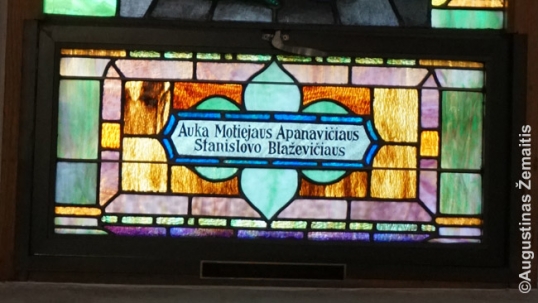
Lithuanian donor names on the stained-glass window of Niagara Falls Lithuanian church
St. George Lithuanian church is, however, located in what is considered a bad district where crime and urban blight is rampant. As such, the church has few faithful attending its Mass while its primary mission now is charity for the inhabitants of the area. Many lots are now empty in the surroundings with their buildings destroyed yet the St. George Lithuanian church continues to have use and purpose.
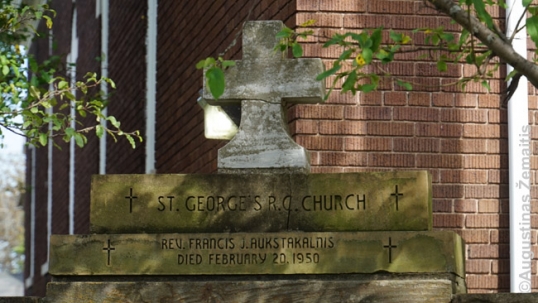
Memorial to the former priest outside of the church
Utica Lithuanian church and cemetery
Utica city of New York state has both Lithuanian church and a Lithuanian cemetery (one of merely three Lithuanian cemeteries in the entire state of New York).
Utica St. George Lithuanian church is a small building dating to 1967 when it replaced an older church. It is one of the smallest Lithuanian churches in America. It has been closed in 2007 and stands empty.

Utica St. George Lithuanian church
St. George Lithuanian cemetery is where the members of the Lithuanian parish used to be buried and one may see many Lithuanian graves there, although nearly no Lithuanian inscriptions or those mentioning Lithuania as the cemetery was established after the Lithuanian-Americans who came before World War 1 (the bulk of Utica community) were somewhat assimilated.

A grave inscribed with 'Born in Lithuania'. Given the later date for establishment of the cemetery such inscritions are rare.
The gate has an English-only inscription and is dedicated to Balutis family. There are many Lithuanian surnames.
The cemetery is located along the same road as many other ethnic and minority cemeteries of Utica.

St. George Lithuanian cemetery in Utica
Binghamton Lithuanian heritage
Lithuanians (~500) also live in Binghamton. This community's history is similar to its many "siblings" in Upstate New York. It began before World War 1 and the highest point of Lituanity was in the 1930s. This golden era is still reminded by a dusty inscription "Lithuanian Natl. Assc. Inc." on a ~1917 building at 315 Clinton Street. While the building has few surviving Lithuanian details, it is otherwise very authentic; so authentic, in fact, that it is one of the very few Lithuanian buildings to be inscribed into the USA's National Register of Historic Places. What served Lithuanians as offices and event hall, now serves the local Tri-City Opera which has acquired the building in 1964 and used it as its base since.
City landmarks list also lists "Sokolvonia" building (~1939) as Lithuanian although a likely Slavic name may indicate a mistake.
Subsequently, the membership of many Lithuanian organizations grew older, the usage of Lithuanian language grew limited to ethnic events. However, many still guarded cherished folk customs and amber jewelry as something that reminded them of their homeland. The arrival of refugees after the occupation of Lithuania (~1950) triggered a limited rebirth of Binghamton Lituanity. However, the DPs left the Upstate New York for work-laden major cities once they could.
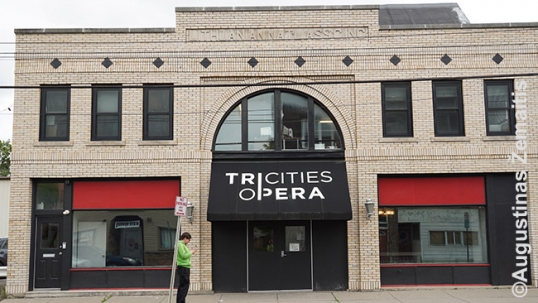
Binghamton Lithuanian Association building

Remaining Lithuanian inscription on the Lithuanian club.
Like elsewhere, the church life survived the longest in Binghamton. The modern facade of St. Joseph Lithuanian church (1 Judson Ave, built in 1949-1950) still has a Lithuanian inscription over its doors. However, the building has been sold to Grace Tabernacle church in 2008. Multiple ethnic parishes have been consolidated into a single Holy Trinity parish in the former St. Ann Church. Some things of St. Joseph have been moved in there: electric organ, carillon, the Last Supper. The sources claim that the Lithuanian church had an especially ethnic interior - priest Valkavičius, who wrote about the Lithuanian-American parishes, even suggested tourists to stop and look at it.

Binghamton Lithuanian church.
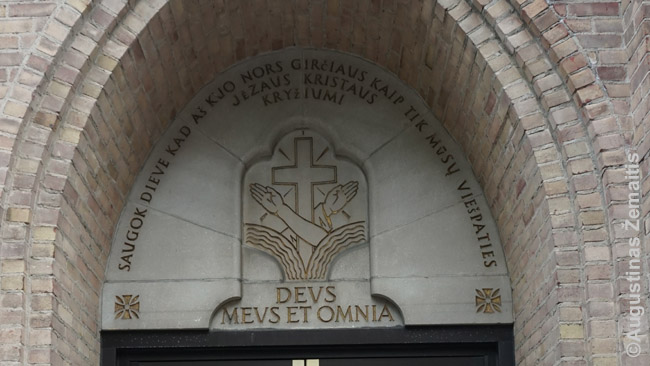
Binghamton Lithuanian church entrance with the Lithuanian text ‚Guard me, oh God, from bragging in anything but in cross of our Lord Jesus Christ‘.
In addition to the "New Church", there is also the Old Lithuanian church on the other side of the street (built in 1916), which later served as a parish hall. Its cornerstone still boasts a Lithuanian inscription reminding of its church origins.
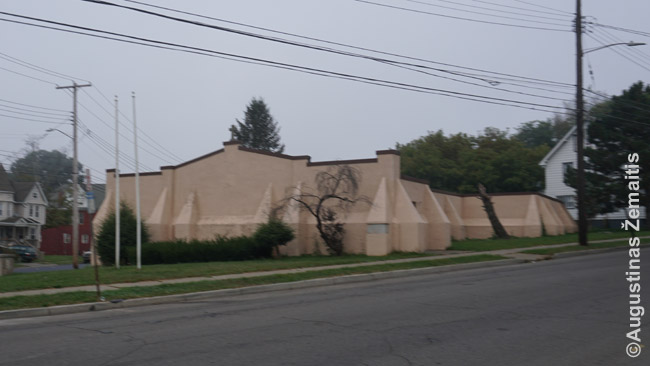
The old Lithuanian ‚basement church‘ in Bingamton.
The map
All the Lithuanian locations, described in this article, are marked on this interactive map, made by the "Destination - America" expedition (click the link):
Interactive map of New York Lithuanian sites
Interactive map of Mohawk Valley Lithuanian sites




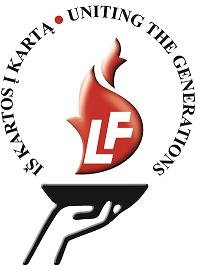

May 15th, 2014 - 03:10
https://sites.google.com/site/lhsofr/
Please add all active organizations, under specific cities.
May 16th, 2014 - 09:33
Thanks, the information on Rochester Lithuanian heritage is available at the Upstate New York article, I have updated it somewhat now: http://global.truelithuania.com/upstate-new-york-831/
December 9th, 2017 - 17:02
Thank you for this. St. Josephs (St. Joes) was my home church that my family attended. The old church across Glenwood Ave, was where many wedding receptions were held. I learned to Polka there. We called it St. Joes hall. The Lithuanian Association building was a few doors down from my father’s shop (Grigor’s Electric) at 331 Clinton St. This brought back many memories of my youth.
December 22nd, 2017 - 06:45
Saint Joseph’s in Binghamton was also my home church. I was an altar boy in the basement church and the new church across the street. The Lithuanian Association building also contained an excellent pool table which many teenagers enjoyed. Thank you for publishing these excellent memory items.
December 22nd, 2017 - 14:10
Thank you for sharing your memories! Do you know if the building with inscription “Sokolvonia” on top (on the same street as the Lithuanian National Association) had anything to do with Lithuanians and, if so, what? Also, at what time are you speaking about – when did the National Association close?
April 10th, 2018 - 10:44
St Casimir’s in Amsterdam still has its original stained glass windows; they were too expensive to remove and were sold with the church. The one in the facade shows the Mother of God Crowning St Casimir. The ceilings still have the murals, since they are too high to paint over. The murals have images of St. Casimir, Our Lady of Vilnius, Our Lady of Siluva, Our Lady of Czestochowa. The 7′ tall statue of St Casimir that once stood in the high altar is now in St Mary’s church. There were two murals in the sanctuary, of St Casimir leading the Lithuanians into battle, and on the other side, St Casimir raising a girl from the dead, but these have been painted over. You can still go inside, but only when the Buddhists are having services.
April 11th, 2018 - 08:10
Thank you for clarification and description! During the “Destination America 2017” mission, we were unable to get inside – although there was a woman, presumably a Buddhist caretaker, nearby, she refused to let us in (which was, actually, the only such situation during the mission, as in all other cases we were either let inside the previously-Lithuanian buildings or there was simply nobody present to ask).
However, we arrived not during a Buddhist service time, therefore it is indeed possible that the church is visitable during these times by non-Buddhists as well.
February 29th, 2020 - 11:56
You two have done and continue to do an excellent job with all of the various Lithuanian churches and businesses. Is there a way to financially contribute to your organization to help with ongoing online research and travel expenses?
February 29th, 2020 - 17:13
Thank you!
There are two ways to contribute financially:
1.One time donation via Paypal: https://www.paypal.com/donate/?token=tMMQ6fPZ1aEoDYLpxgttCLWtMCCikH88N7o6rz4D5amUkaSxAMHxVjOuaZIC41j8bU3jK0&country.x=LT&locale.x=LT
2.Recurring (monthly) donation via Patreon: https://www.patreon.com/truelithuania
Additionally, you may contribute to the project in a non-financial way by helping to spread the word about it, contacting the media in the areas in question, suggesting additional places to be added and researching these places, etc.
July 8th, 2020 - 19:45
The cemetery for St. Joseph’s Lithuanian Church parishioners is Calvary Cemetery in Johnson City.
Binghamton’s first ward had a large Lithuanian community.
Before the church was built Mass was held at the church hall shown. Originally, that was supposed to be the basement of a church to be built on top of it.
July 9th, 2020 - 14:19
Is the said cemetery only of this parish (i.e. a Lithuanian cemetery) or was it used together with other, non-Lithuanian, parishes, or is there a certain Lithuanian-only (this-parish-only) section there?
December 29th, 2020 - 00:55
I lived in Amsterdam, NY growing up in a Lithuanian neighborhood and belonging to St. Casimir’s Church. My family also belonged to the American Lithuanian Club where my family had all our family wedding receptions there. I remember my family always spoke Lithuanian in our house while I was growing up.
March 8th, 2022 - 20:47
Laba diena! Mano gyvenimas irgi taip buva. Dabar gyvenu miesti arti New York. Mano vardas Maryte.